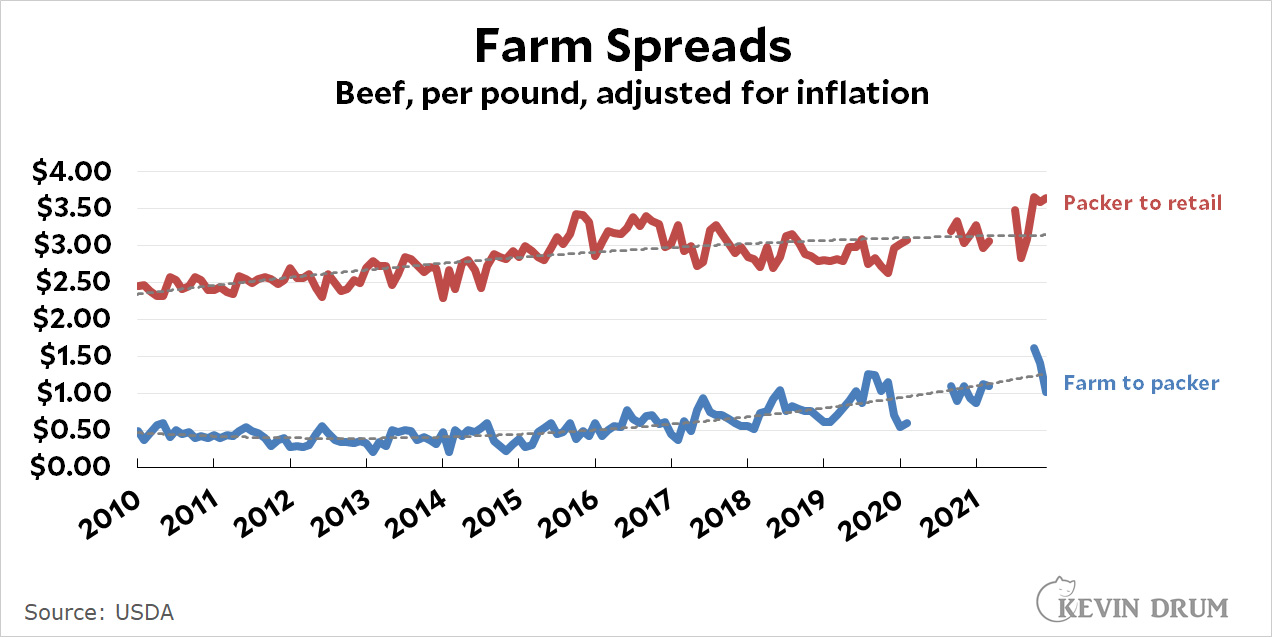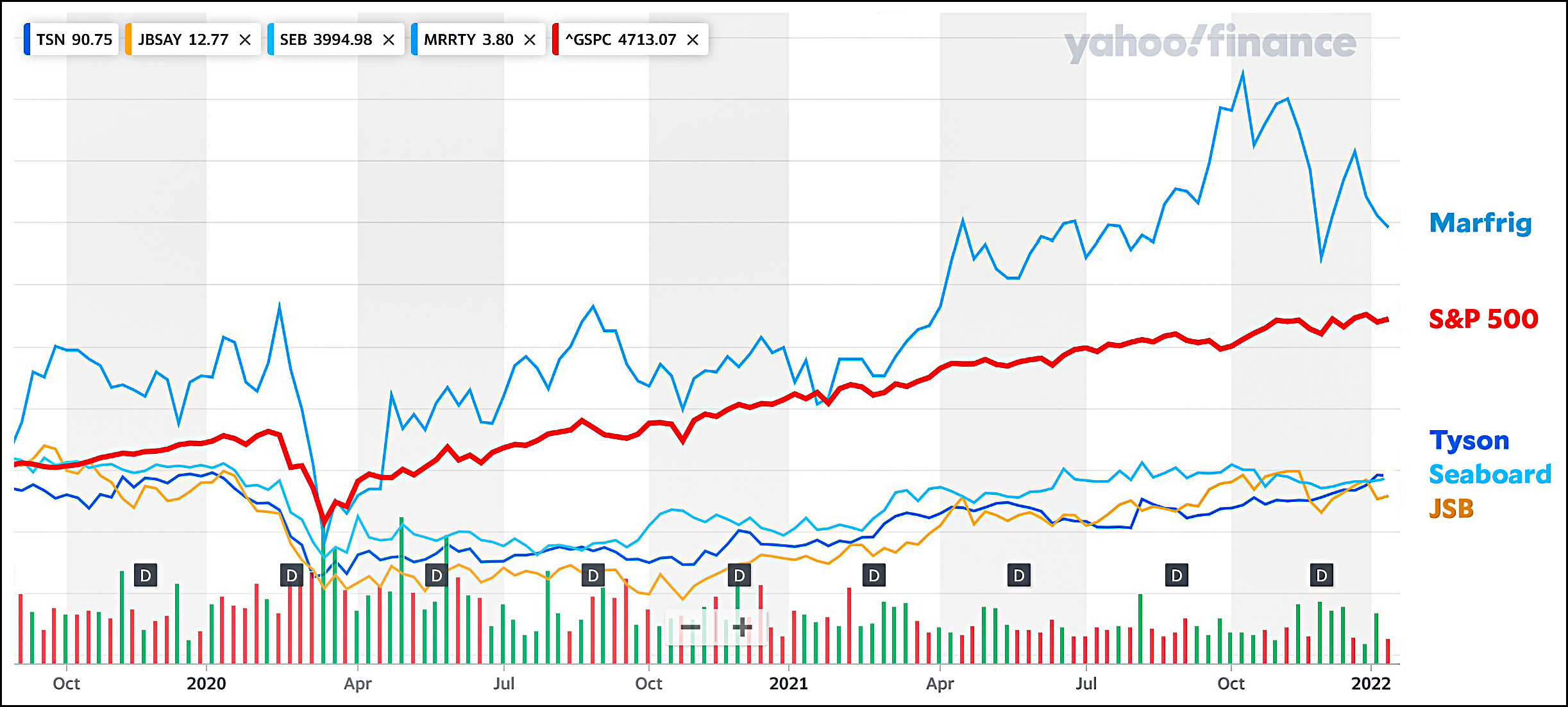Why are beef prices so high? Is it because the meatpacking industry is monopolized by four big companies who are exploiting their pricing power at a moment of maximum leverage?
Let's find out. The USDA maintains an astonishing set of statistical data, including 50 years of pricing data. Conveniently for us, one of the things they track is the "spread," the difference between the price of beef at the ranch, at the meatpacker, and at the supermarket. Without further ado, here it is since 2010:
 In order to track this fairly, I've eliminated two recent episodes of huge, short spikes caused by the pandemic. The result is what you see: ranchers sell beef at about $1 more than their cost while meatpackers are selling for about $3.50 more.
In order to track this fairly, I've eliminated two recent episodes of huge, short spikes caused by the pandemic. The result is what you see: ranchers sell beef at about $1 more than their cost while meatpackers are selling for about $3.50 more.
(Note that this is not profit. It's merely the difference in price. To calculate profit we'd need to subtract the cost of production.)
At the same time, beef production has been steadily rising:
 It's hard to see much of anything here. Meatpackers have enjoyed a bit of a rise just in the past three months, but otherwise have been on a flat trendline since about 2016. Ranchers have been on an upswing since 2015, rising from 50 cents to around a dollar. This is likely because they have to make up for higher feed and other production costs.
It's hard to see much of anything here. Meatpackers have enjoyed a bit of a rise just in the past three months, but otherwise have been on a flat trendline since about 2016. Ranchers have been on an upswing since 2015, rising from 50 cents to around a dollar. This is likely because they have to make up for higher feed and other production costs.
Finally, the USDA says that the retail price of a pound of beef has gone up about $1.50 over the past two years while the total spread from ranch to supermarket has gone up about $1. This means that supermarket spreads have gone up about 50 cents.
Oddly, what this all suggests is that ranchers and supermarkets are responsible for most of the increase in the price of beef. Meatpackers, aside from a couple of very short recent spikes, are marking up beef about the same as they have since 2016.
None of this means that everything is well. Meatpackers may be squeezing ranchers unfairly thanks to their monopoly power. However, when it comes to the price of beef on the supermarket shelf, they seem to be fairly blameless.
UPDATE: One of the quickest ways of checking out the overall health of a company is to simply look at its stock price. If it's raising prices at will and collecting monster profits, its stock price should soar. Here are the stock prices of the Big Four meatpackers in the US:
 Marfrig is doing OK, but the other three are sucking wind. Investors sure aren't impressed by their alleged ability to jack up prices whenever they feel like it.
Marfrig is doing OK, but the other three are sucking wind. Investors sure aren't impressed by their alleged ability to jack up prices whenever they feel like it.

PBS had a show on this a while back.
Cattle ranchers are being tuned into chicken producers--i.e. more and more are raising cattle under contract. And contract pricing is not public. I'm not sure how that skews auction prices.
There have also been recent sell offs of herds due to drought conditions. But no buyers--i.e. slaughterhouses were full.
Frontline's Modern Meat is from 2002.
Recent article on problems with drought:
https://www.pbs.org/newshour/nation/as-drought-cuts-hay-crop-cattle-ranchers-face-culling-herds
And for an interesting perspective from local ranchers--from 2020:
https://www.pbs.org/video/missouri-cattle-industry-pnodpd/
...and yes, armadillos are spreading north.
Interesting and informative post. Now what I had heard specifically is that the profits of the meat packers has gone up significantly - I was told that the companies are public so you can find out that information. Of course maybe my source was wrong.
Personally, in my supermarket the beef prices haven’t moved much, but the chicken prices are noticeably higher. YMMV.
I’m not a day trader, so my impression may be wrong, but the many times I’ve heard investors and business analysts talking, they have always emphasized future earnings. I heard that over and over again. It is why tech stocks took off long before the companies made profits. And why Amazon’s stock has been so high for so long even though for much of their history they made no profits. (I for one welcome our future Amazon overlords.) In any case, a 6 month spike in profits doesn’t automatically translate to higher stock prices if everyone assumes the profits will disappear in a short while.
In any case, I’m kind of surprised that there isn’t more about why the meat prices are rising so much. I see that golack has brought up the problems cattle ranchers have had. That has been mentioned in the comments before - I don’t know if it was golack or someone else. I’m sure if I searched around I could find more about it, but my usual news sources only talk about the short term vs long term inflation argument. Not why chicken is the new gold for inflation hawks.
Reminds of a time in my life when I married into a commercial fishing family. They also built boats. So I read The National Fisherman newspaper. Mostly for the boat building articles by John Gardner. That was back in the previous century; a long ways back. Read an article complaining about the price of fish paid at the boat vs the supermarket price. I expect small guys who raise beef have the same beef.
Where's the beef? Eaters, I mean. Seems that hardly anyone I know eats the stuff, or at the least, prepares it at home. I know, I know, but anecdote time: Last week one of friends asked us if we like steak, because they got a freezerful of the stuff as a Christmas gift and they don't know what to do with it. Bottom line was, we declined with thanks, preferring to stick with eggs, tuna, and vegetable protein for our daily bread (ducks.) Now admittedly, most of the people I know will never see sixty again. But still.
I'm surprised that beef is still a "thing", given how exorbitant its price is (even greasy hamburger!), its link to heart disease and stroke, and its disproportionate environmental effects.
Must be some kind of bizarre mystique, like brandishing a firearm, right? Because "In A Sane World" (the running joke of the century so far), rising prices would mean decreased consumption.
Kevin, I work at USDA/ERS and I think you're misinterpreting our data. What you show as "Farm to Packer" is the spread between the price received for cattle by the rancher and the price received for wholesale beef by the packer. That spread measures packer costs plus profits, and it's doubled since 2015 after showing virtually no trend change over the previous 35 years. That's a pretty striking development and not, as you show, just pandemic-related.
The "Packer to Retail" line is the difference between wholesale and retail prices, and measures costs and profits in retail, transportation, and further processing. This USDA series doesn't estimate rancher costs or profits, just the price they get.
I went to Five Guys the other day. Got a Little Bacon Cheeseburger, fries & Reg drink. Was shocked when the total was over $20. Realized the burger was disproportionate in terms of cost of the meal.